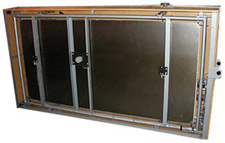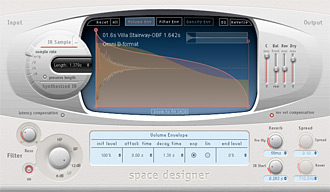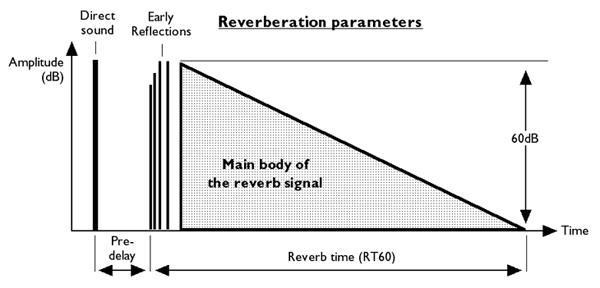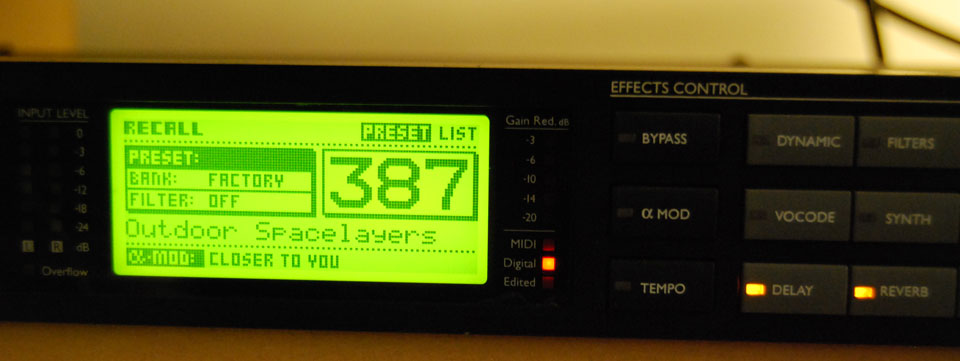Methods of reverberation
How to program a digital reverb processors to simulate different rooms
How to hook-up reverberation processors in the studio.
You may wish to read Theories of reverberation before continuing.
Methods of reverberation
Mic placement
Utilising the ambient sound of the recording environment by placing microphones at different distances from musicians.
Echo chambers
When the first professional recording studios were built suitably reflective rooms were constructed within which were placed a loudspeaker and one or two microphones. A signal is sent to the speaker and the resulting reverberation is picked up by the microphones.
Plate reverb device

Plate reverb
This device comprises a large, thin metal plate (several square metre's in size) to which is attached a driving transducer (loudspeaker) which vibrates the plate, and one or two receiving transducers (pick ups/mics) which pick up the resulting resonance.
Spring reverb
First developed by Hammond in the US, the concept is similar to a plate except that a piece of coiled wire is used instead of a metal plate. Although of poorer quality, they are physically smaller and lighter and can therefore be installed into instrument amplifiers (typically guitar combos and heads).
Digital reverb processors
With improvements in CPU power in the early 1980’s, digital simulation of reverb effects became possible and affordable. These technologies allow a new degree of controllability and have several unique features not offered by their analogue counterparts.
Digital studio reverb device
Hardware/software types
Today digital reverb is available in several hardware and software based guises ...
- Out board rack processors.
- Instrument based (keyboards, sound modules, drum machines etc).
- Audio sequencer based plug-ins.
- DSP processor based plug-ins (both PCI expansion card and FireWire connected rack hardware).
- Guitar pedals.
- Digital mixers, live powered mixers.
Guitar reverb pedal

Algorithms
Software "recipes" called algorithms, digitally "model" different types of reverb. Each algorithm will have adjustable parameters to fine tune its sound.
When programming a reverb device it is important to choose an appropriate "ballpark" algorithm first before fine tuning/adjusting its various parameters. Today a typical digital reverb unit will offer these algorithms ...
- (Echo) Chamber
- Room.
- (Concert) Hall
- Plate
- Gated reverb - an effect whereby the RT is artificially curtailed
- Reverse
Space Designer, Logic's convolution plug-in

Convolution
Recent improvements in processing power have given rise to both hardware and plug-in based convolution technologies. Most popular audio sequencing applications (Logic, Cubase, Performer etc) now come with a convolution reverb plug-in.
A convolution based reverb processor does not attempt to "artificially" model the characteristics of a reverberant space (an algorithm), but instead employs an impulse response (a recording of the reverberation characteristics of a space) to process a signal and imprint the exact same reverb characteristics on it as if it were recorded in the same space.
Convoluting reverbs can create extremely realistic results but do not allow the same flexibility of parameter adjustments as an algorithm based processor.
Algorithm based digital reverb parameters
The user interfaces these machines employ allow sophisticated manipulation of parameters by way of buttons, dials and LCD’s. Most processors offer a selection of manufacturer preset patches which once edited can be stored and recalled from patch memories.
Typically a user may edit ...
-
Pre-delay In a large room there will be a delay between the direct sound and the ER’s.
-
Reverb time (RT60) The length of time it takes for the level of reverberation at 1kHz to decrease by 60dB (virtually to silence). This depends on several factors, room size, shape, type of reflective surfaces etc.
-
Hi-Frequency Decay/Damping This control lets you set a shorter reverb time for the high frequencies. this is useful when emulating high frequency absorption.
-
Diffusion The pattern or spread of the reverberation. A high diffuse reverb setting will produce a smooth and even sound. A low diffusion setting will result in a lumpy of semi-echoy sound.
-
Early reflections (ERs) Following the direct sound, these are the first reflections to arrive at the listeners ear from the most nearby surfaces in a room before the start of the main part of the reverb and define the listeners perception of the size and character of the acoustical space.
-
Patch / program Name Once edited a program may be named and stored.

Programming reverb
When programming a reverb device to emulate different acoustical spaces you must consider ...
- Room size.
- Absorption characteristics and arrangement of objects and surfaces.
- Choose an appropriate algorithm / program.
- Set an appropriate Pre-delay.
- Set an appropriate Reverb Time.
- Set an appropriate High Frequency Decay/Damping setting.
- Set an appropriate Diffusion setting.
|
Pre-delay | Reverb time | Diffusion | Hi-freq decay |
|---|---|---|---|---|
| Concert hall | 50ms | 2.5 sec | Lots | Lots |
| Cathedral | 100ms | 5 sec | Some | Little |
| Bathroom | 10ms | 0.5 sec | Little | None |
| Sitting room | 20ms | 0.25 sec | Lots | Lots |
Hook up
Use the Aux sends of a mixing desk to create a copy of the source sound and route it to the input of the reverb processor. In this way many channels may access and share a single processor. It's output may then be brought back into 2 unused mixer Input Channels (stereo) or a dedicated mixer effects return channel(s). This process is identical for hardware and software based mixers. You can insert a processor into a single channel but it will only process that one channel.
Most digital devices can create a stereo reverb effect either from a mono or stereo source signal ...
- Mono in - Stereo out.
- Stereo in - Stereo out.
![]()
Mixer Auxillary signal flow diagram
Dry & wet signals
In the recording studio we call the direct sound the Dry signal, and the effect the Wet signal.

